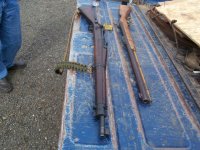tahunua001
New member
... looking for mosin nagants and an SR22 but instead this guy followed me home

1903(I'm guessing A1).
I got it for a very decent price and it is in excellent condition. it's a 5XXXXX serial number that is all springfield parts with the exception of the bolt which is a remington refurb item from WWII. overall I would I would say that I am very happy with the acquisition. it's a very decent rifle though it does hit around 6 inches high with USG surplus at 100 yards and I can't figure out how to adjust for elevation but I am used to holding low for my Enfield No4 MK1 so it's not that bad, hunting accuracy anyway.

1903(I'm guessing A1).
I got it for a very decent price and it is in excellent condition. it's a 5XXXXX serial number that is all springfield parts with the exception of the bolt which is a remington refurb item from WWII. overall I would I would say that I am very happy with the acquisition. it's a very decent rifle though it does hit around 6 inches high with USG surplus at 100 yards and I can't figure out how to adjust for elevation but I am used to holding low for my Enfield No4 MK1 so it's not that bad, hunting accuracy anyway.
Last edited:
